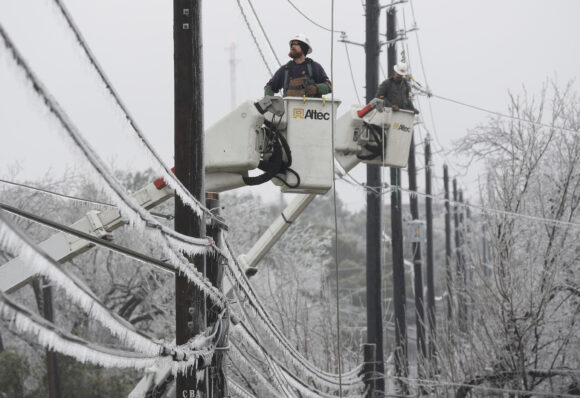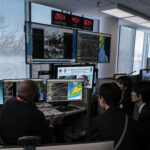AUSTIN, Texas (AP) — A mess of ice, sleet and snow lingered across much of the southern U.S. on Thursday as thousands in Texas endured freezing temperatures with no power, including many in the state capital of Austin, but a warming trend was forecast to bring relief from the deadly storm.
Hundreds more flights were canceled again in Texas, although not as many as in previous days. But another wave of frigid weather in the U.S. is on the horizon, with an Arctic cold front expected to move from Canada into the northern Plains and Upper Midwest and sweep into the Northeast by Friday. The front is expected to bring snow and wind chills lower than minus 50 (minus 45 Celsius) to northern New England, according to the National Weather Service.
More than 416,000 customers in Texas lacked power early Thursday, according to PowerOutage, a website tracking utility reports.
The outages were most widespread in Austin, where frustration mounted among more than 150,000 customers, over 24 hours after their electricity and heat went out. For many, it was the second time in three years that a February deep freeze caused prolonged outages and uncertainty over when the lights would come back on.
Unlike the 2021 blackouts in Texas, when hundreds of people died after the state’s grid was pushed to the brink of total failure because of a lack of generation, the outages in Austin this time were largely the result of frozen equipment and trees falling on power lines. The city’s utility warned all power may not be restored until Friday as ice continued causing new outages, even as repairs were finished elsewhere.
“It feels like two steps forward and three steps back,” said Jackie Sargent, general manager of Austin Energy.
School systems in the Dallas and Austin area, plus many in Oklahoma, Arkansas and Memphis, Tennessee, closed Thursday as snow, sleet and freezing rain continued to push through. Public transportation in Dallas also experienced “major delays” early Thursday, according to a statement from Dallas Area Rapid Transit.
Airport crews battled ice to keep runways open. By Thursday morning, airlines had canceled more than 500 flights at Dallas-Fort Worth International Airport _ more than a quarter of all flights scheduled for the day. Still, that was down from about 1,300 cancellations on Wednesday and more than 1,000 on Tuesday, according to FlightAware.com.
Dozens more flights Thursday were canceled at Dallas Love Field and Austin-Bergstrom International Airport.
Watches and warnings about wintry conditions stretched from the West Texas border with Mexico through Oklahoma, Arkansas and Louisiana and into western Tennessee and northern Mississippi. And in a briefing Thursday with the federal Weather Prediction Center, New Englanders were warned that wind chills — the combined effect of wind and cold air on exposed skin — in the minus 50s “could be the coldest felt in decades.”
The strong winds and cold air will create wind chills “rarely seen in northern and eastern Maine,” according to an advisory from the National Weather Service office in Caribou, Maine.
Jay Broccolo, director of weather operations at an observatory on New Hampshire’s Mount Washington _ which for decades held the world record for the fastest wind gust _ said Thursday that wind speeds could top 100 mph (160 kph).
“We take safety really seriously in the higher summits, and this weekend’s forecast is looking pretty gnarly, even for our standards,” Broccolo said.
At least nine people have died due to treacherous road conditions since Monday, including seven in Texas and one each in Oklahoma and Arkansas. Texas Gov. Greg Abbott urged people not to drive.
Top photo: Austin Energy linemen Ken Gray, left, and Chad Sefcik work to restore power on ice-covered lines along West Alpine Road during a winter storm, Wednesday, Feb. 1, 2023, in Austin, Texas. (Jay Janner/Austin American-Statesman via AP)
Was this article valuable?
Here are more articles you may enjoy.


 US Weather Service Merges Units as Staffing Pressure Rises
US Weather Service Merges Units as Staffing Pressure Rises  Fed’s Powell Says Tariff Impact Likely to Be Larger Than Expected
Fed’s Powell Says Tariff Impact Likely to Be Larger Than Expected  TikTok’s New Owner Stands to Inherit 1,500 Safety, Privacy Suits
TikTok’s New Owner Stands to Inherit 1,500 Safety, Privacy Suits  Trump’s Tariffs Send Deliberate Shock to Heart of Global Economy
Trump’s Tariffs Send Deliberate Shock to Heart of Global Economy 